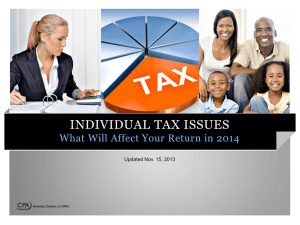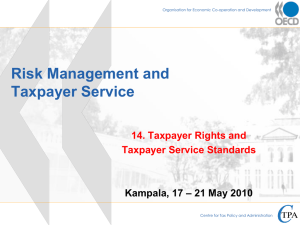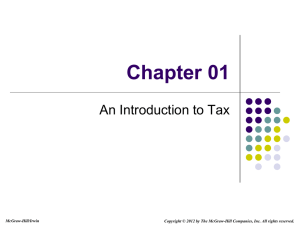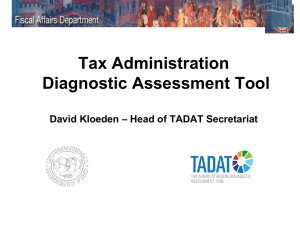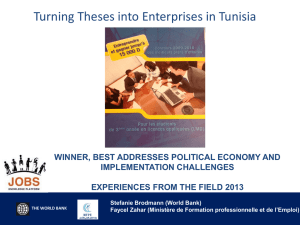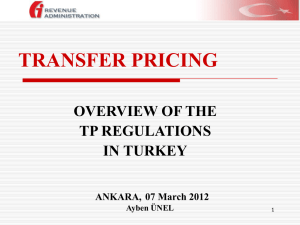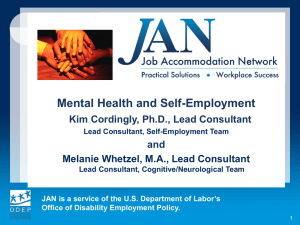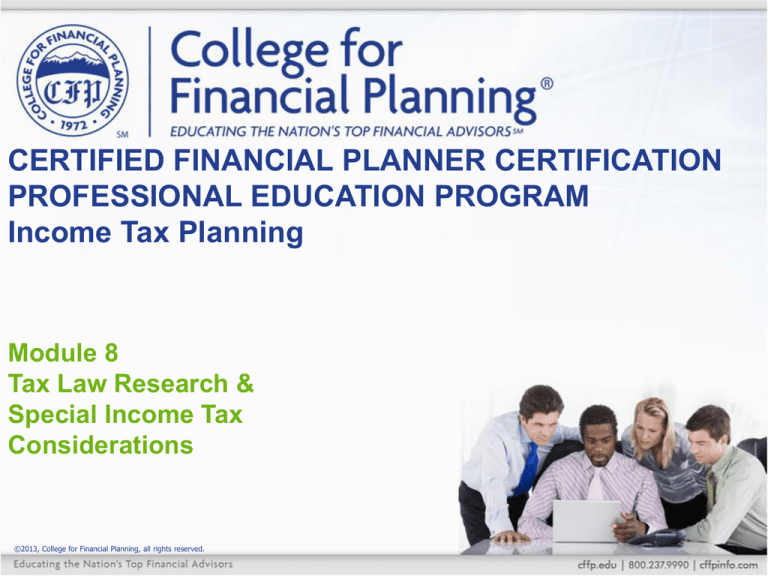
CERTIFIED FINANCIAL PLANNER CERTIFICATION
PROFESSIONAL EDUCATION PROGRAM
Income Tax Planning
Module 8
Tax Law Research &
Special Income Tax
Considerations
©2013, College for Financial Planning, all rights reserved.
Learning Objectives
8–1:
8–2:
8–3:
8–4:
8–5:
Identify the purpose of a given provision of the federal tax law.
Identify characteristics of the audit process.
Identify the sources of authority for reliance on tax-related issues.
Identify the steps necessary to research a tax problem properly.
Identify tax preference items or adjustments for the alternative
minimum tax for noncorporate taxpayers.
8–6: Analyze a situation to calculate the alternative minimum tax for
noncorporate taxpayers.
8–7: Analyze a situation to calculate the self-employment tax.
8–8: Identify characteristics or consequences of tax traps or tax
penalties.
8–9: Analyze a situation to calculate tax penalties or penalty taxes.
8–10: Analyze a situation to identify tax traps present.
8–11: Analyze a situation to identify the potential for the imposition of a
tax penalty.
8–12: Identify ethical considerations in tax planning.
8-2
Questions to Get Us Warmed Up
8-3
Learning Objectives
8–1:
8–2:
8–3:
8–4:
8–5:
Identify the purpose of a given provision of the federal tax law.
Identify characteristics of the audit process.
Identify the sources of authority for reliance on tax-related issues.
Identify the steps necessary to research a tax problem properly.
Identify tax preference items or adjustments for the alternative
minimum tax for noncorporate taxpayers.
8–6: Analyze a situation to calculate the alternative minimum tax, or
Medicare contribution tax, for individual taxpayers.
8–7: Analyze a situation to calculate the self-employment tax.
8–8: Identify characteristics or consequences of tax traps or tax
penalties.
8–9: Analyze a situation to calculate tax penalties or penalty taxes.
8–10: Analyze a situation to identify tax traps present.
8–11: Analyze a situation to identify the potential for the imposition of a
tax penalty.
8–12: Identify ethical considerations in tax planning.
8-4
Purposes of the Federal Tax Law
RevenueRaising
Objectives
• individual
income tax
• corporate
income tax
Economic
Objectives
Social
Objectives
• price stability
• economic
growth
• full
employment
• economic
incentives
• relief
provisions
8-5
IRS Audit Systems
• Discriminant Function Systems Program (DIF)
• Taxpayer Compliance Measurement Program
•
•
•
(TCMP)
Targeted Programs Audit
Document Matching
Program
National Research
Program (NRP)
8-6
Research of a Tax Problem
•
•
•
•
•
•
Assemble the facts
Identify the problem
Locate authority on the issue
Evaluate authority in terms of the issue
Develop one or more solutions
Communicate the solutions
8-7
Authority for Reliance on Tax-Related Issues
•
•
•
•
•
•
The Internal Revenue Code and Regulations: source of all
federal tax law and highest statutory authority
Treasury Department Decisions: authorized by law and
having the full force and effect of law
Revenue Rulings and Revenue Procedures: may be cited as
precedents but do not have the force and effect of Treasury
Department Regulations
Congressional Committee Reports: indicates
congressional intent when a law is enacted
o not precedential
IRS Private Letter Rulings: indicate the probable
approach of the IRS in a particular situation
Court Decisions: judicial decisions interpret tax
law or facts related to a particular case
8-8
Learning Objectives
8–1:
8–2:
8–3:
8–4:
8–5:
Identify the purpose of a given provision of the federal tax law.
Identify characteristics of the audit process.
Identify the sources of authority for reliance on tax-related issues.
Identify the steps necessary to research a tax problem properly.
Identify tax preference items or adjustments for the alternative
minimum tax for noncorporate taxpayers.
8–6: Analyze a situation to calculate the alternative minimum tax, or
Medicare contribution tax, for individual taxpayers.
8–7: Analyze a situation to calculate the self-employment tax.
8–8: Identify characteristics or consequences of tax traps or tax
penalties.
8–9: Analyze a situation to calculate tax penalties or penalty taxes.
8–10: Analyze a situation to identify tax traps present.
8–11: Analyze a situation to identify the potential for the imposition of a
tax penalty.
8–12: Identify ethical considerations in tax planning.
8-9
Alternative Minimum Tax
• Enacted in 1969
• Parallel tax system
• Designed to ensure that
•
“high-income” taxpayers
pay at least a minimum
amount of taxes
Good news—ATRA indexes
exemption and phaseout
numbers, and start of 28%
bracket
8-10
Alternative Minimum Tax
Items of Tax Preference & Adjustments of
the AMT for Noncorporate Taxpayers
Accelerated cost recovery deductions
• on real property in excess of the straight-line method
• on leased property in excess of the straight-line
method
• for personalty placed in service after 1986 to the
extent the deductions exceed the 150% decliningbalance method
8-11
Alternative Minimum Tax
Items of Tax Preference & Adjustments of
the AMT for Noncorporate Taxpayers
• Excess intangible drilling costs (IDC)
• Percentage depletion in excess of adjusted
basis
• The bargain element on the exercise of an
incentive stock option
• Rapid amortization of a certified pollution
control facility in excess of the alternative
depreciation method
8-12
Alternative Minimum Tax
Items of Tax Preference & Adjustments of
the AMT for Noncorporate Taxpayers
• Tax-exempt interest on qualified private-activity
municipal bonds (but not for bonds issued in
2009 and 2010)
• Passive farm losses are treated as a preference
item
• A portion (generally 7%) of the gain excluded
from sale of some qualified small business stock
• Research and experimental costs, circulation
expenses, and mining exploration and
development costs
8-13
Alternative Minimum Tax
Calculation for Noncorporate Taxpayers
Increase adjusted gross income (AGI) by any tax
preference items and increase or decrease by any
adjustments
Reduce the figure determined in Step 1 by the
allowable itemized deductions
Reduce the figure determined in Step 2 by the
appropriate exemption amount; the resulting figure is
the alternative minimum taxable income
8-14
Alternative Minimum Tax
Calculation for Noncorporate Taxpayers
Apply a tax rate of 26% to the alternative minimum tax
base up to $179,500 and apply 28% to the excess over
$179,500 to determine the alternative minimum tax
amount.
Compare the AMT amount to the regular tax
• if the regular tax after credits equals or exceeds the AMT amount,
then no AMT payment is required.
• if the regular tax is less than the AMT, then the difference is the
AMT payable (i.e., additional tax) required.
Reduce the AMT payment by any refundable credits,
personal nonrefundable credits, and the low-income
housing credit for post-2007 property.
8-15
AMT & Itemized Deductions
Many itemized deductions disallowed:
• state and local income taxes
• property taxes
• Tier-II miscellaneous itemized deductions
Itemized deductions treated differently:
• medical expenses
exceeding 10% of AGI
• qualified housing interest
8-16
Learning Objectives
8–1:
8–2:
8–3:
8–4:
8–5:
Identify the purpose of a given provision of the federal tax law.
Identify characteristics of the audit process.
Identify the sources of authority for reliance on tax-related issues.
Identify the steps necessary to research a tax problem properly.
Identify tax preference items or adjustments for the alternative
minimum tax for noncorporate taxpayers.
8–6: Analyze a situation to calculate the alternative minimum tax, or
Medicare contribution tax, for individual taxpayers.
8–7: Analyze a situation to calculate the self-employment tax.
8–8: Identify characteristics or consequences of tax traps or tax
penalties.
8–9: Analyze a situation to calculate tax penalties or penalty taxes.
8–10: Analyze a situation to identify tax traps present.
8–11: Analyze a situation to identify the potential for the imposition of a
tax penalty.
8–12: Identify ethical considerations in tax planning.
8-17
Self-Employment Tax
• Self-employment income—from trade or business
•
•
•
•
as sole proprietorship, general partner or
independent contractor, or rental of personalty
Self-employment income reduced by 7.65% prior to
computation of self-employment tax
15.3% up to wage base of $113,700 (2013)
2.9% Medicare with no ceiling
One-half of the self-employment tax deductible as
adjustment to income
• Additional Medicare tax of 0.9% on self-employment
income over $200,000 for single taxpayers, or $250,000
(combined self-employment income) for joint returns
- no adjustment to income for this portion of S/E tax
8-18
Medicare Contribution Tax
• The tax is 3.8% of the lesser of the
o net investment income, or
o the excess of the modified AGI (MAGI) over
the specified threshold amount
Filing Status
Single
Threshold
$200,000
Head of household
$200,000
Married filing jointly
$250,000
• Net investment income
o investment income reduced by
• penalty on the early withdrawal of savings
• investment interest expense
• Tier II investment expenses after 2% of AGI
8-19
Medicare Contribution Tax
Investment income includes gross income
from:
o
o
o
o
o
interest, substitute interest
dividends, substitute dividends
annuities
net capital gains, net royalties, net rental income
passive business income
Specifically not included in investment
income:
o muni bond interest
o income from active trades or businesses
o income from qualified plans—including 401(k)s, 403(b)s,
IRAs, Roth IRAs, and 457 plans.
8-20
Learning Objectives
8–1:
8–2:
8–3:
8–4:
8–5:
Identify the purpose of a given provision of the federal tax law.
Identify characteristics of the audit process.
Identify the sources of authority for reliance on tax-related issues.
Identify the steps necessary to research a tax problem properly.
Identify tax preference items or adjustments for the alternative
minimum tax for noncorporate taxpayers.
8–6: Analyze a situation to calculate the alternative minimum tax, or
Medicare contribution tax, for individual taxpayers.
8–7: Analyze a situation to calculate the self-employment tax.
8–8: Identify characteristics or consequences of tax traps or tax
penalties.
8–9: Analyze a situation to calculate tax penalties or penalty taxes.
8–10: Analyze a situation to identify tax traps present.
8–11: Analyze a situation to identify the potential for the imposition of a
tax penalty.
8–12: Identify ethical considerations in tax planning.
8-21
Tax Traps
Characteristic/Consequence
Substance over form
The substance of a transaction, not merely its
form, governs its tax consequences.
Assignment of income
Income is taxed to the “tree” that grows the
“fruit,” even though assigned to another prior
to receipt.
Tax benefit rule
Recovery or refund of a previously deducted
item may be taxed. Most often this is
applicable to a refund of state income taxes,
or reimbursement of medical expenses.
Reallocation of income
The IRS may reallocate items among
taxpayers to “clearly reflect income.”
Constructive receipt doctrine
For a cash basis taxpayer, income is reported
when it is available without restriction.
8-22
Tax Traps
Characteristic/Consequence
Step transaction
The various steps of a multiple-step
transaction may be collapsed, and the entire
transaction taxed as if it took place in a single
step.
Hobby loss
A taxpayer must have a profit motive for
engaging in a trade or business, or else
losses will not be deductible.
Forgiveness of debt
Generally taxable unless the debt is forgiven
in bankruptcy or the debtor is insolvent.
Sham transaction
Transactions that lack a business purpose and
economic substance will be ignored for tax
purposes.
8-23
Tax Penalties
Penalty
Calculation
Negligence
20% of the income tax deficiency attributable to negligence
Fraud (civil)
75% of the income tax deficiency attributable to fraud (not
interest)
Failure to file
5% of the tax due for each month the return is late, up to a
maximum of 25%
Minimum of the lesser of $135 or 100% of the tax if more
than 60 days late
Failure to pay
½% per month of unpaid tax; maximum of 25%
8-24
Accumulated Earnings Tax
• $150,000 accumulation limit for PSC
• $250,000 accumulation limit for non-PSC
• Must prove valid business purpose for additional
accumulations:
o bond sinking fund
o expansion of business
o other reasonable need of the business
8-25
Accumulated Earnings Tax Computation
• C Corporation taxable income
• MINUS:
•
o federal income tax paid
o dividends paid
o accumulated earnings credit*
EQUALS:
o excess accumulations
(taxed at 20%)
*$250,000/$150,000 minus the prior accumulations
8-26
Estimated Taxes
• To avoid underpayment penalty, pay the lesser
of:
o 90% of the current year’s tax liability, or
o 100% of the prior year’s tax liability.
• If prior year AGI exceeded $150,000, then pay
o 90% of the current year’s tax liability, or
o 110% of the prior year’s tax liability.
• Safe harbor of $1,000
8-27
Review Question 1
Assume a taxpayer is faced with a tax
deficiency of $15,000, along with interest on
the deficiency of $2,200. The entire deficiency
resulted from an honest error in applying the
tax law from the taxpayer’s 2011 return.
What is the amount of the penalty?
a. $1,500
b. $3,000
c. $4,100
d. $11,250
8-28
Review Question 2
Which one of the following is not a step in the
tax research process?
a. obtaining all the facts
b. diagnosing the problem from the facts
c. obtaining a letter ruling from the IRS if the
issue is novel
d. communicating the answer
8-29
Review Question 3
Which one of the following is not a step in the
calculation of the alternative minimum tax?
a. Adjusted gross income is decreased by any net
operating losses and tax preference and adjustment
items.
b. Adjusted gross income is increased by any net
operating losses and tax preference items and
increased or decreased by the adjustment items.
c. The net amount of alternative minimum taxable
income is reduced by an appropriate exemption
amount to arrive at the AMT base.
d. The AMT payable is reduced by any refundable
credits.
8-30
Review Question 4
Which one of the following is not an allowable
itemized deduction against alternative minimum
taxable income?
a. medical expenses in excess of 10% of
adjusted gross income
b. charitable contributions
c. qualified housing interest
d. state and local income taxes
8-31
Review Question 5
Which one of the following statements is true
with regard to self-employment taxes?
a. A taxpayer is allowed to deduct a portion of
his or her self-employment tax liability as an
adjustment to income.
b. The wage base is not adjusted annually for
cost of living increases.
c. Net earnings from self-employment must be
calculated under the accrual method of
accounting.
d. Self-employed taxpayers are subject to
employer withholding.
8-32
Review Question 6
Which one of the following rules or doctrines
deals with determining whether or not a
taxpayer retains control over the “tree” and is
thus taxed or not taxed on its “fruit”?
a. the constructive receipt doctrine
b. the tax benefit rule doctrine
c. the assignment of income doctrine
d. the sham transaction doctrine
8-33
Review Question 7
Which one of the following statements correctly defines
negligence as it applies to imposition of the penalty?
a. Negligence is bad faith conduct by a taxpayer who
has an intent to evade paying income tax.
b. Negligence is intentional conduct by a taxpayer to
avoid paying income tax.
c. Negligence is a failure to make a reasonable attempt
to comply with provisions of the Internal Revenue
Code.
d. Negligence is an intentional disregard of the
provisions of the Internal Revenue Code that results
in a substantial underpayment.
8-34
Review Question 8
Which one of the following is not a primary
objective of the federal tax law system?
a. raising revenue
b. economic growth and development
c. social objectives
d. political stability
8-35
Review Question 9
A Treasury regulation is
a. a general administrative interpretation of
statutory tax law.
b. the source of statutory tax law.
c. an administrative interpretation of statutory
tax law that is generally related to specific
circumstances of fact.
d. an administrative interpretation of statutory
tax law that is generally related to
compliance issues.
8-36
Review Question 10
All of the following are preference items for
purposes of the individual alternative minimum
tax except
a. interest on qualified private-activity
municipal bonds issued in 2008.
b. the bargain element on exercise of an
incentive stock option.
c. the excess of percentage depletion over the
property’s adjusted basis.
d. investment interest in excess of net
investment income.
e. excess intangible drilling costs.
8-37
Review Question 11
Sandy McVey has Schedule C net income of
$40,000. Sandy also has a general partnership
interest from which she received a flow-through
of operating income of $5,858. She also has a
flow-through from an S corporation of $15,000.
What is the amount of self-employment tax that
Sandy must pay for the current tax year?
a. $6,480
b. $7,016
c. $8,599
d. $9,311
8-38
Review Question 12
ABC Corporation has the following items of income and expense:
Taxable income
Federal income tax
Accumulated earnings and profits at the
end of the preceding tax year
Dividends paid in current year
$210,000
$59,000
$190,000
$10,000
Assume ABC is not a personal service corporation and cannot
establish a valid business purpose for its excess accumulations.
What is the amount, if any, of accumulated earnings tax payable?
a. $0
b. $16,200
c. $28,000
d. $28,200
8-39
Review Question 13
Which one of the following is not a relief
provision that applies to federal income
taxation?
a. exclusion for life insurance proceeds
b. Section 179 expense election
c. child care credit
d. additional standard deduction for the elderly
or blind
8-40
Review Question 14
Jerry Nelson has Schedule C net income of
$150,000. He also has a flow-through from an S
corporation of $10,000. What is the amount of
self-employment tax that he must pay for the
current tax year?
a. $17,396
b. $18,116
c. $18,384
d. $22,607
8-41
CERTIFIED FINANCIAL PLANNER CERTIFICATION
PROFESSIONAL EDUCATION PROGRAM
Income Tax Planning
Module 8
End of Slides
©2013, College for Financial Planning, all rights reserved.

